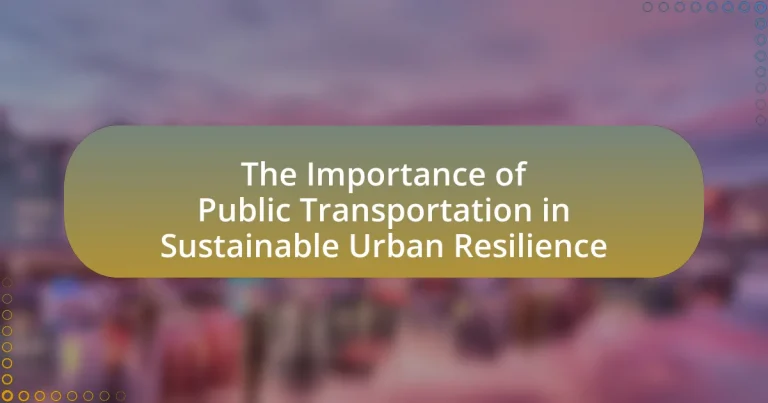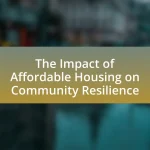Public transportation is a vital component of sustainable urban resilience, significantly reducing traffic congestion, greenhouse gas emissions, and enhancing accessibility for all residents. It plays a crucial role in promoting social equity by connecting underserved communities to essential services and employment opportunities. The article explores how effective public transit systems contribute to urban resilience by providing reliable mobility during emergencies, supporting economic sustainability, and fostering community cohesion. Key features of resilient transportation systems, such as adaptability and integration, are discussed, along with the challenges faced by public transit in urban environments. Additionally, the article highlights future trends, including the integration of electric and autonomous vehicles, and the impact of technology on improving public transportation efficiency and user experience.
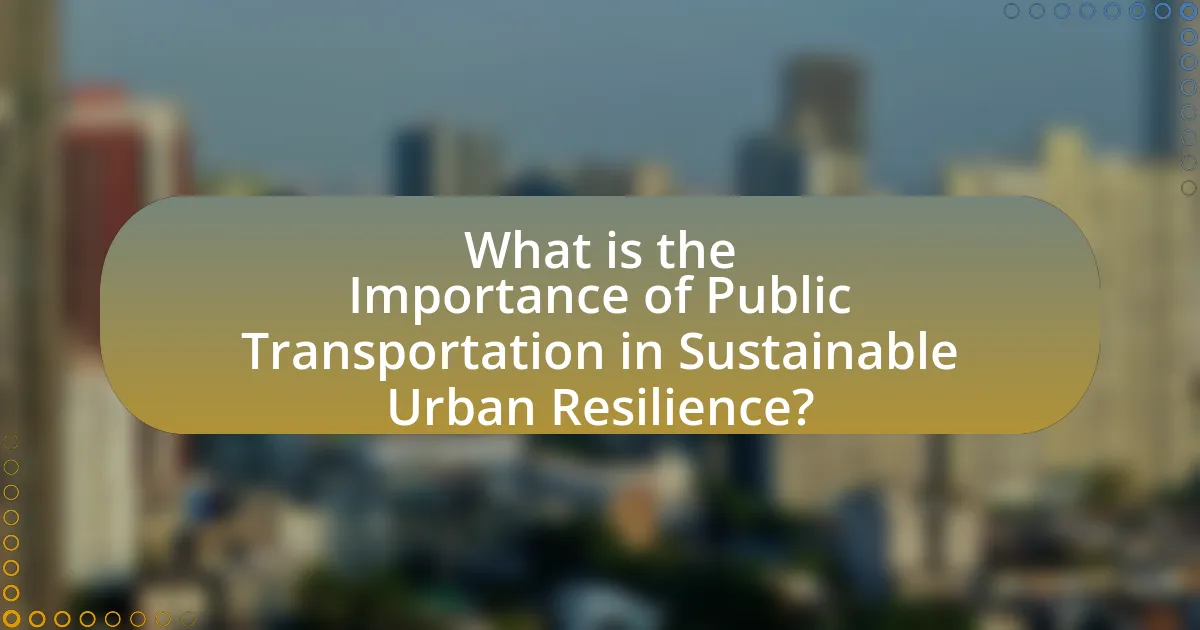
What is the Importance of Public Transportation in Sustainable Urban Resilience?
Public transportation is crucial for sustainable urban resilience as it reduces traffic congestion, lowers greenhouse gas emissions, and enhances accessibility. By providing efficient transit options, cities can decrease reliance on personal vehicles, which contributes to improved air quality and reduced urban sprawl. According to the American Public Transportation Association, public transit saves approximately 45 million metric tons of carbon dioxide annually, highlighting its role in combating climate change. Furthermore, effective public transportation systems promote social equity by ensuring that all residents, regardless of income, have access to essential services and employment opportunities, thereby strengthening community resilience.
How does public transportation contribute to urban resilience?
Public transportation enhances urban resilience by providing reliable mobility options during emergencies and reducing dependency on personal vehicles. This system allows for efficient evacuation and access to essential services, which is critical in disaster scenarios. For instance, cities with robust public transit networks can maintain connectivity and support recovery efforts more effectively, as seen in New York City during Hurricane Sandy, where public transit played a vital role in post-storm recovery. Additionally, public transportation contributes to environmental sustainability by lowering greenhouse gas emissions, which mitigates climate change impacts, further strengthening urban resilience.
What are the key features of resilient urban transportation systems?
Key features of resilient urban transportation systems include adaptability, redundancy, and integration. Adaptability allows transportation systems to respond effectively to changing conditions, such as population growth or climate impacts, ensuring continued functionality. Redundancy provides alternative routes and modes of transport, which enhances reliability during disruptions, such as natural disasters or infrastructure failures. Integration involves the seamless coordination of various transportation modes, including public transit, cycling, and walking, which promotes accessibility and reduces reliance on single-occupancy vehicles. These features collectively contribute to a transportation system’s ability to withstand and recover from adverse events, thereby supporting sustainable urban resilience.
How does public transportation reduce vulnerability in urban areas?
Public transportation reduces vulnerability in urban areas by providing accessible mobility options that enhance social equity and emergency response capabilities. By connecting underserved communities to essential services, public transit mitigates isolation and ensures that all residents can access healthcare, employment, and education. Furthermore, during emergencies, public transportation systems can facilitate efficient evacuations and deliver aid, as evidenced by studies showing that cities with robust transit networks recover more quickly from disasters. For instance, research from the Transportation Research Board highlights that cities with integrated public transit systems experience lower mortality rates during crises, demonstrating the critical role of public transportation in fostering urban resilience.
Why is public transportation essential for sustainability?
Public transportation is essential for sustainability because it significantly reduces greenhouse gas emissions and energy consumption compared to private vehicle use. Studies indicate that public transit systems can reduce per capita carbon emissions by up to 45% in urban areas, as they facilitate higher occupancy rates and lower energy use per passenger mile. Additionally, public transportation promotes efficient land use and decreases traffic congestion, leading to further environmental benefits. According to the American Public Transportation Association, every $1 invested in public transit generates approximately $4 in economic returns, highlighting its role in fostering sustainable urban development.
What environmental benefits does public transportation provide?
Public transportation significantly reduces greenhouse gas emissions, contributing to improved air quality and decreased urban congestion. According to the American Public Transportation Association, public transit saves approximately 45 million metric tons of carbon dioxide annually, equivalent to the emissions from over 9 million cars. Additionally, public transportation systems promote energy efficiency, as they typically consume less energy per passenger mile compared to private vehicles. This efficiency leads to lower fossil fuel consumption and a reduced carbon footprint, supporting sustainable urban resilience.
How does public transportation support economic sustainability?
Public transportation supports economic sustainability by reducing transportation costs for individuals and businesses, thereby enhancing overall economic efficiency. Efficient public transit systems lower the need for personal vehicle ownership, which can save households an average of $9,000 annually in transportation expenses, according to the American Public Transportation Association. Additionally, public transportation fosters job creation, with every $1 invested in public transit generating approximately $4 in economic returns, as reported by the Federal Transit Administration. This investment not only stimulates local economies but also attracts businesses and promotes urban development, contributing to a more sustainable economic environment.
What role does public transportation play in social equity?
Public transportation plays a crucial role in promoting social equity by providing accessible mobility options for all individuals, regardless of socioeconomic status. It enables low-income communities to access essential services such as employment, education, and healthcare, thereby reducing disparities in opportunities. Studies indicate that cities with robust public transit systems experience lower levels of income inequality; for instance, the American Public Transportation Association reported that public transit reduces household transportation costs by approximately $9,000 annually, which significantly benefits economically disadvantaged groups. Furthermore, equitable public transportation planning can enhance community cohesion and support diverse populations, fostering inclusive urban environments.
How does access to public transportation affect marginalized communities?
Access to public transportation significantly enhances the mobility and economic opportunities for marginalized communities. Improved access allows individuals in these communities to reach employment, education, and healthcare services more easily, thereby reducing social isolation and increasing participation in the economy. For instance, a study by the American Public Transportation Association found that public transit access can increase job opportunities by up to 50% for low-income individuals. Furthermore, reliable public transportation can lead to a decrease in transportation costs, which disproportionately burden marginalized groups, allowing them to allocate resources to other essential needs.
What initiatives can enhance equity in public transportation systems?
Initiatives that can enhance equity in public transportation systems include implementing fare subsidies for low-income riders, expanding service coverage to underserved areas, and improving accessibility for individuals with disabilities. Fare subsidies can reduce financial barriers, as evidenced by programs in cities like San Francisco, where low-income residents receive discounts, leading to increased ridership among economically disadvantaged groups. Expanding service coverage ensures that all communities, particularly those historically marginalized, have access to reliable transportation options; for instance, cities like Seattle have invested in extending bus routes to reach low-income neighborhoods. Additionally, improving accessibility, such as through the installation of ramps and elevators, is crucial for individuals with disabilities, as highlighted by the Americans with Disabilities Act, which mandates accessible public transportation. These initiatives collectively contribute to a more equitable public transportation system, fostering inclusivity and enhancing urban resilience.
How can public transportation systems be improved for better resilience?
Public transportation systems can be improved for better resilience by integrating advanced technology, enhancing infrastructure, and increasing community engagement. Implementing real-time data analytics and predictive modeling can optimize service delivery and adapt to changing conditions, as evidenced by cities like Los Angeles, which uses data to adjust bus routes based on demand fluctuations. Strengthening infrastructure through regular maintenance and upgrades ensures systems can withstand extreme weather events, supported by studies showing that resilient infrastructure reduces service disruptions by up to 30%. Additionally, involving communities in planning processes fosters trust and ensures services meet local needs, as demonstrated by participatory budgeting initiatives in cities like Paris, which have led to increased public satisfaction and usage of transportation services.
What challenges do public transportation systems face in urban resilience?
Public transportation systems face significant challenges in urban resilience, primarily due to funding constraints, infrastructure deterioration, and adaptability to climate change. Funding limitations hinder the ability to maintain and upgrade transit systems, leading to service disruptions and reduced reliability. For instance, a report from the American Public Transportation Association indicates that U.S. public transit agencies face a collective funding gap of $89 billion over the next decade, impacting their operational capacity. Additionally, aging infrastructure poses risks, as many systems were built decades ago and require substantial investment to modernize. Lastly, the increasing frequency of extreme weather events necessitates that public transportation systems adapt to climate change, which often requires innovative solutions and additional resources. These factors collectively undermine the effectiveness of public transportation in contributing to urban resilience.
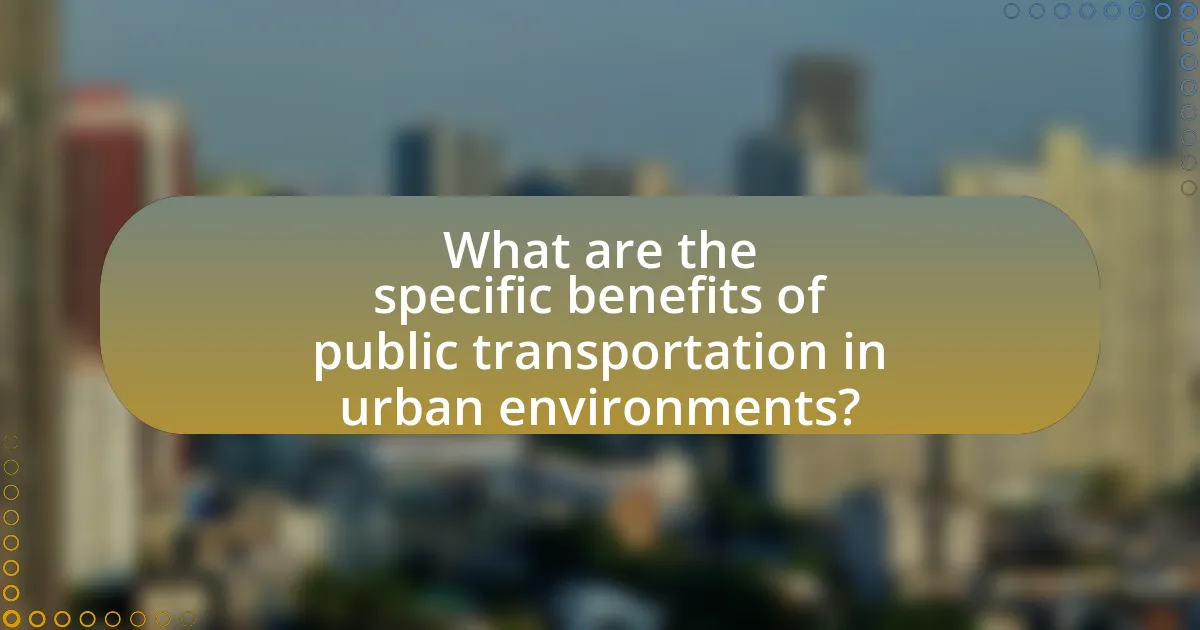
What are the specific benefits of public transportation in urban environments?
Public transportation in urban environments offers several specific benefits, including reduced traffic congestion, lower greenhouse gas emissions, and increased accessibility. By providing an efficient alternative to private vehicles, public transit systems can significantly decrease the number of cars on the road, which in turn alleviates traffic jams. According to the American Public Transportation Association, public transit saves approximately 45 million metric tons of carbon dioxide annually, contributing to improved air quality and environmental sustainability. Furthermore, public transportation enhances accessibility for individuals without private vehicles, enabling them to reach jobs, education, and essential services, thereby promoting economic growth and social equity in urban areas.
How does public transportation impact traffic congestion?
Public transportation significantly reduces traffic congestion by providing an efficient alternative to private vehicle use. Studies indicate that increased public transit ridership can lead to fewer cars on the road; for instance, the American Public Transportation Association reports that public transit saves approximately 4.2 billion gallons of gasoline annually, which translates to a reduction of about 1.4 billion vehicle trips. This decrease in the number of vehicles directly alleviates congestion, particularly during peak travel times. Furthermore, cities with robust public transportation systems often experience lower levels of traffic congestion, as evidenced by research from the Texas A&M Transportation Institute, which found that areas with higher public transit usage have less severe traffic delays.
What strategies can be implemented to reduce congestion through public transport?
Implementing dedicated bus lanes is a key strategy to reduce congestion through public transport. These lanes prioritize buses, allowing them to bypass traffic and improve travel times, which encourages more people to use public transport. For instance, cities like Bogotá, Colombia, have successfully implemented TransMilenio, a bus rapid transit system with dedicated lanes, resulting in a 30% reduction in travel times and a significant increase in ridership. Additionally, integrating real-time tracking systems for public transport can enhance efficiency by providing passengers with accurate arrival information, further promoting the use of buses and trains. Studies show that cities with real-time tracking see a 10-15% increase in public transport usage.
How does reduced congestion contribute to urban resilience?
Reduced congestion enhances urban resilience by improving mobility and access to essential services during emergencies. Efficient transportation systems allow for quicker evacuation, timely delivery of resources, and better response times for emergency services. For instance, cities with reduced traffic congestion can facilitate faster movement of ambulances and fire trucks, which is critical during disasters. Additionally, studies show that cities with effective public transportation systems experience lower congestion levels, leading to increased economic stability and social cohesion, both vital components of urban resilience.
What health benefits are associated with public transportation use?
Public transportation use is associated with several health benefits, including increased physical activity, reduced air pollution, and improved mental health. Regularly using public transit often involves walking to and from transit stops, which contributes to higher levels of physical activity. A study published in the American Journal of Preventive Medicine found that individuals who use public transportation engage in more physical activity compared to those who drive. Additionally, public transportation can lead to lower vehicle emissions, resulting in improved air quality, which is linked to better respiratory health. Furthermore, using public transit can reduce stress and promote social interaction, contributing positively to mental well-being. Research from the Transportation Research Board indicates that access to public transportation can enhance community connectivity, which is beneficial for mental health.
How does public transportation promote physical activity among users?
Public transportation promotes physical activity among users by encouraging walking and cycling as part of their daily commute. Users often walk to and from transit stops, which increases their overall physical activity levels. A study published in the American Journal of Preventive Medicine found that individuals who use public transit engage in significantly more physical activity compared to those who rely on private vehicles, with an average increase of 30 minutes of walking per week. This integration of active transportation modes contributes to improved public health outcomes and supports sustainable urban resilience by reducing reliance on cars and lowering greenhouse gas emissions.
What are the mental health benefits of using public transportation?
Using public transportation can significantly enhance mental health by reducing stress and promoting social interaction. Commuting via public transit often alleviates the anxiety associated with driving, such as traffic congestion and parking challenges. Research indicates that individuals who use public transportation report lower levels of stress and higher overall life satisfaction compared to those who drive. Additionally, public transit facilitates social connections, as it provides opportunities for interaction with others, which can combat feelings of loneliness and isolation. A study published in the Journal of Transport and Health found that regular use of public transportation is linked to improved mental well-being, highlighting its role in fostering community engagement and support networks.
How does public transportation influence urban planning and development?
Public transportation significantly influences urban planning and development by shaping land use patterns, reducing traffic congestion, and promoting sustainable growth. Urban planners often prioritize transit-oriented development, which encourages higher density housing and mixed-use spaces near transit hubs, thereby maximizing accessibility and minimizing reliance on personal vehicles. For instance, cities like Portland have implemented light rail systems that have led to increased property values and economic development in surrounding areas, demonstrating the positive correlation between public transit availability and urban revitalization. Additionally, studies show that regions with robust public transportation systems experience lower greenhouse gas emissions, supporting sustainable urban resilience initiatives.
What are the best practices for integrating public transportation in urban design?
The best practices for integrating public transportation in urban design include creating a comprehensive transit network, ensuring accessibility, promoting mixed-use development, and prioritizing pedestrian and cyclist infrastructure. A comprehensive transit network connects various modes of transportation, such as buses, trains, and bike-sharing systems, facilitating seamless travel across the urban area. Accessibility is crucial; public transport should be reachable for all demographics, including those with disabilities, as evidenced by the Americans with Disabilities Act, which mandates accessible public transit. Mixed-use development encourages residential, commercial, and recreational spaces to coexist, reducing the need for long commutes and promoting public transport use. Additionally, prioritizing pedestrian and cyclist infrastructure enhances safety and encourages non-motorized transport, which has been shown to reduce traffic congestion and improve air quality in urban environments. These practices collectively contribute to sustainable urban resilience by fostering efficient, equitable, and environmentally friendly transportation systems.
How can public transportation shape land use patterns in cities?
Public transportation can significantly shape land use patterns in cities by promoting higher density development and mixed-use areas. When efficient public transit systems are established, they encourage residential and commercial growth near transit hubs, leading to reduced urban sprawl. For instance, cities like Portland, Oregon, have seen a 20% increase in housing units near light rail stations, demonstrating how transit accessibility influences land use decisions. Additionally, public transportation reduces reliance on personal vehicles, which can lead to more pedestrian-friendly environments and increased green spaces, further altering land use dynamics.
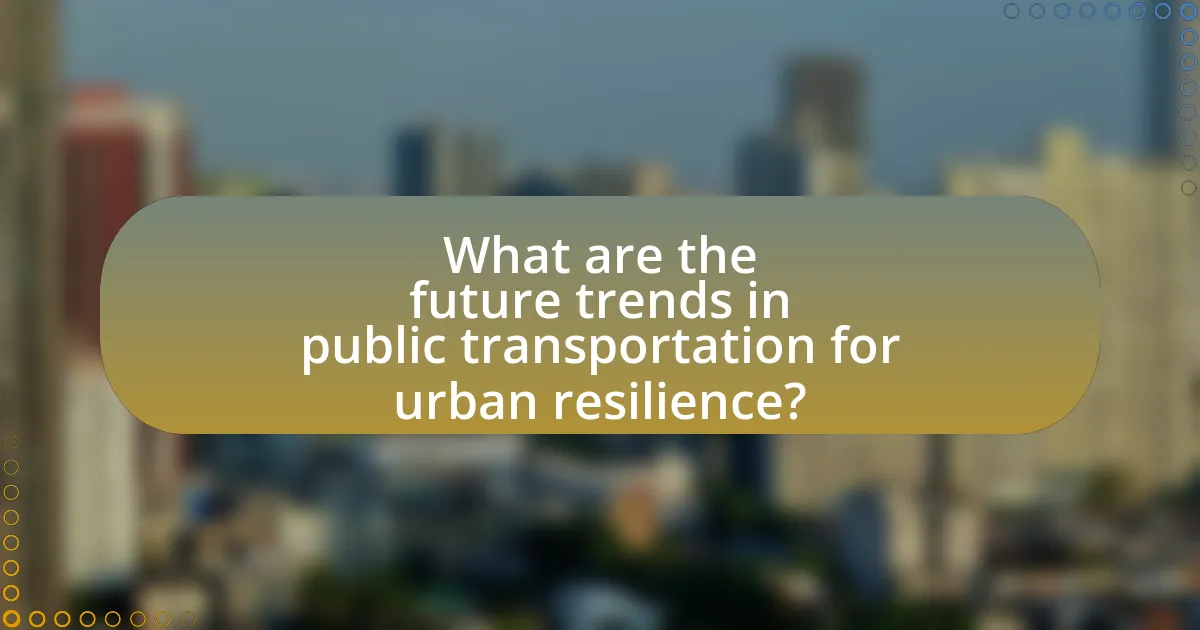
What are the future trends in public transportation for urban resilience?
Future trends in public transportation for urban resilience include the integration of electric and autonomous vehicles, enhanced multimodal transport systems, and the implementation of smart technology for real-time data management. Electric vehicles reduce greenhouse gas emissions, contributing to sustainability; for instance, cities like Los Angeles are expanding electric bus fleets to lower pollution levels. Autonomous vehicles can improve safety and efficiency, as seen in pilot programs in cities like San Francisco. Enhanced multimodal systems facilitate seamless transitions between different transport modes, promoting accessibility and reducing congestion, evidenced by initiatives in cities like Amsterdam. Smart technology, such as predictive analytics and mobile applications, optimizes route planning and improves user experience, as demonstrated by the success of real-time tracking systems in cities like Singapore. These trends collectively aim to create more resilient urban environments capable of adapting to challenges such as climate change and population growth.
How is technology transforming public transportation systems?
Technology is transforming public transportation systems by enhancing efficiency, accessibility, and user experience through innovations such as real-time tracking, mobile ticketing, and data analytics. Real-time tracking systems, like GPS-enabled apps, allow passengers to monitor vehicle locations and arrival times, significantly reducing wait times and improving service reliability. Mobile ticketing solutions streamline fare collection, making it easier for users to purchase tickets via smartphones, which increases ridership and reduces cash handling costs. Additionally, data analytics enables transit agencies to optimize routes and schedules based on passenger demand patterns, leading to more effective resource allocation. For instance, cities implementing smart transit solutions have reported up to a 20% increase in operational efficiency, demonstrating the tangible benefits of technology in public transportation systems.
What role do smart technologies play in enhancing public transportation efficiency?
Smart technologies significantly enhance public transportation efficiency by optimizing routes, improving real-time tracking, and facilitating better communication between transit systems and users. For instance, GPS-based systems allow for dynamic routing, which reduces travel times and minimizes delays. According to a study by the American Public Transportation Association, cities that implemented smart technologies saw a 20% increase in ridership due to improved service reliability and user experience. Additionally, mobile applications provide passengers with real-time updates, enabling them to make informed travel decisions, which further streamlines the overall efficiency of public transportation systems.
How can data analytics improve public transportation services?
Data analytics can improve public transportation services by optimizing route planning and enhancing operational efficiency. By analyzing ridership data, transit agencies can identify peak travel times and adjust schedules accordingly, leading to reduced wait times and increased service reliability. For instance, a study by the American Public Transportation Association found that agencies using data analytics reported a 10-15% increase in ridership due to improved service delivery. Additionally, predictive analytics can help in maintenance scheduling, reducing downtime of vehicles and infrastructure, which further enhances service quality.
What innovations are emerging in public transportation?
Innovations emerging in public transportation include electric and autonomous vehicles, smart ticketing systems, and integrated mobility platforms. Electric vehicles reduce greenhouse gas emissions and improve air quality, with cities like Los Angeles committing to a fully electric bus fleet by 2030. Autonomous vehicles enhance safety and efficiency, as demonstrated by pilot programs in cities such as San Francisco. Smart ticketing systems streamline fare collection and improve user experience, with cities like London implementing contactless payment options. Integrated mobility platforms, such as MaaS (Mobility as a Service), facilitate seamless travel across different modes of transport, promoting greater public transit usage and reducing reliance on personal vehicles.
How are electric and autonomous vehicles shaping the future of public transport?
Electric and autonomous vehicles are significantly transforming public transport by enhancing efficiency, reducing emissions, and improving accessibility. Electric vehicles contribute to lower greenhouse gas emissions, with studies indicating that they can reduce urban transport emissions by up to 70% compared to traditional fossil fuel vehicles. Autonomous vehicles increase operational efficiency by optimizing routes and schedules, which can lead to reduced wait times and improved service frequency. Furthermore, these technologies can enhance accessibility for individuals with mobility challenges, as autonomous shuttles can provide on-demand services in underserved areas. The integration of electric and autonomous vehicles into public transport systems is supported by various cities worldwide, such as Los Angeles and Singapore, which are investing in these technologies to create more sustainable urban environments.
What are the implications of shared mobility services for public transportation?
Shared mobility services significantly impact public transportation by enhancing accessibility, reducing congestion, and promoting sustainable urban mobility. These services, such as ride-sharing and bike-sharing, complement traditional public transit systems by providing first-mile and last-mile solutions, making it easier for users to reach transit hubs. According to a study by the Transportation Research Board, integrating shared mobility with public transportation can lead to a 10-15% increase in public transit ridership, as users find it more convenient to combine these services. Furthermore, shared mobility can decrease the number of single-occupancy vehicles on the road, contributing to lower greenhouse gas emissions and improved air quality, which aligns with the goals of sustainable urban resilience.
What practical steps can cities take to enhance public transportation for sustainability?
Cities can enhance public transportation for sustainability by investing in electric and hybrid vehicles, expanding transit networks, and implementing integrated ticketing systems. Electric and hybrid vehicles reduce greenhouse gas emissions, contributing to cleaner air; for instance, cities like Los Angeles have adopted electric buses, resulting in a significant decrease in emissions. Expanding transit networks increases accessibility, encouraging more people to use public transport; research shows that cities with extensive transit systems, such as Tokyo, experience higher public transport usage rates. Integrated ticketing systems streamline the user experience, making it easier for commuters to switch between different modes of transport, which has been successfully implemented in cities like London, leading to increased ridership.
